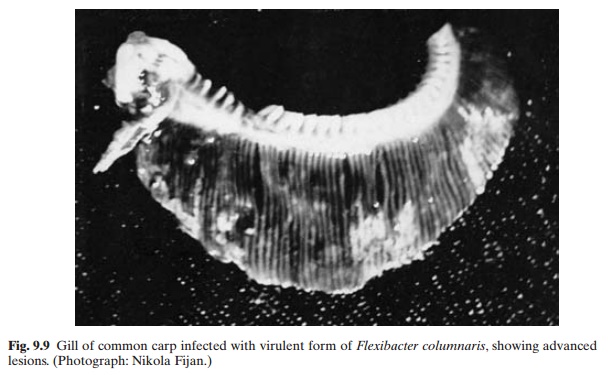Chapter: Aquaculture Principles and Practices: Health and Diseases
Columnaris disease - Bacterial diseases of aquaculture species
Columnaris disease
Columnaris disease occurs in acute or chronic form in both cold-water and warm-water fishes worldwide, and is caused by the bacterium Flexibacter columnaris (fig. 9.9). Strains of high andlow virulence have been identified. The highly virulent form attacks the gill tissue and the less virulent ones are primarily responsible for cutaneous infections.

The first sign of the disease may be the appearance of discoloured grey patches in the dorsal fin area. These lesions grow and expose the underlying muscle tissue. The lesions are prominent in the mouth and head regions and may become yellow and cratered. The infection of virulent strains cause a ‘gill rot’ condition, whereas the systemic infections by less virulent strains may not show any external signs. Cutaneous infections are prevalent among most species of fish.
A preliminary diagnosis of the disease can be made based on the detection of long, slender, gram-negative rods in smears of gills or scrappings from cutaneous lesions (fig. 9.10). The diagnosis can be confirmed by isolation of the organism on cytophaga medium. Colonies of F.columnaris exhibit a rough, rhizoid-marginatedgrowth that tends to extend into the agar.

Infected fish with gill or cutaneous lesions serve as a source of infection; fish under stress due to elevated temperatures and crowding are susceptible to infection. The period between exposure and outbreak of the clinical disease varies, depending on the virulence of the bacterial strain and the ambient water temperature. High-virulence strains may induce acute
disease within 24 hours, whereas less virulent forms may require from 48 hours to several weeks. The disease definitely has a pronounced seasonal occurrence, and is concentrated during the warm summer months.
Avoidance of exposure to the disease, use of disinfected water supplies, reduced population density and maintenance of lower temperature (in the case of cold-water species below 13°C) are possible means of preventing the disease.
Prophylactic treatments can be adopted when other measures are not feasible. Baths of copper sulphate (CuSO4) for 20 minutes at 33 ppm or of potassium permanganate (KMnO4) at 2 ppm for indefinite periods have been recommended; but care should be taken in their administration, since these chemicals can be toxic to certain species in soft waters. Such baths have also been recommended in chemotherapy of the disease. Besides CuSO4 and KMnO4, quaternary ammonium compounds at doses of 2–3 ppm in one-hour flow-through treatments have been reported to be effective for salmonids. Oxytetracycline (terramycin) incorporated into the food at the rate of 4 g per 45 g fish, fed at 3 per cent body weight per day, is the usual antibiotic treatment
Related Topics